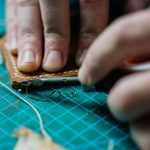When you're ready to iron canvas, it's essential to set up your workspace efficiently. You'll need an iron, ironing board, and a pressing cloth to protect the fabric. Depending on the type of canvas you have, the heat setting will vary—cotton requires high heat while synthetic blends need something more moderate. Laying the canvas flat is just the beginning; there are specific techniques that can make a significant difference in achieving that crisp look you want. What happens when stubborn wrinkles refuse to budge?
Table of Contents
Key Takeaways
- Always check the fabric label for the recommended heat setting specific to your canvas type before ironing.
- Use a pressing cloth to protect the canvas from scorching and shiny spots during the ironing process.
- Mist the canvas lightly with water or use steam to help relax stubborn wrinkles before ironing.
- Iron in straight lines from one corner to the opposite, applying gentle, even pressure to avoid new creases.
Understanding Canvas Fabric
Canvas fabric, known for its durability and versatility, is a popular choice for everything from art supplies to outdoor gear. You'll find it in backpacks, tents, and even shoes, making it a staple in various industries. Typically made from cotton or linen, canvas features a robust weave that gives it strength and resistance to wear and tear.
When you choose canvas for your projects or items, you're opting for a fabric that stands up to daily use. It's breathable yet sturdy, making it ideal for both indoor and outdoor applications. However, because it's a heavier fabric, it can wrinkle easily, especially after washing or prolonged storage.
Understanding the characteristics of canvas will help you maintain its appearance and functionality. You'll discover that its natural fibers allow for easy dyeing, which means you can find it in a variety of colors and patterns. This versatility makes it perfect for custom art projects or stylish outdoor gear.
As you work with canvas, remember that its unique qualities require specific care techniques to keep it looking fresh and crisp.
Tools Needed for Ironing
To get started with ironing canvas, you'll need a few specific tools that make the process easier and more effective. Having the right gear on hand can save you time and help you achieve that crisp, polished look you desire.
Here's a quick overview of the essential tools you'll need:
| Tool | Purpose |
|---|---|
| Iron | The main tool for smoothing out wrinkles |
| Ironing Board | Provides a stable, flat surface for ironing |
| Spray Bottle | Helps to lightly mist the fabric for better results |
Additionally, consider using a pressing cloth. This thin fabric acts as a barrier between the iron and the canvas, preventing scorching or shiny spots. If you want to add some extra weight, a steam iron can help release stubborn wrinkles more effectively.
Lastly, a lint roller can be handy for removing any dust or debris from your canvas before you start. With these tools ready, you're all set to make your canvas look fresh and crisp!
Preparing Your Canvas
Before you start ironing, you need to prepare your canvas properly.
First, choose the right type of canvas for your project.
Then, clean and inspect it for any flaws.
Choose Appropriate Canvas Type
Choosing the right type of canvas is essential for achieving the best results when ironing. Different canvas materials can react differently to heat and pressure, so knowing what you're working with can save you time and effort. Here's a quick guide to help you choose the right canvas type:
| Canvas Type | Best Use | Ironing Temperature |
|---|---|---|
| Cotton Canvas | Art projects, bags | Medium (300°F) |
| Duck Canvas | Upholstery, tents | High (400°F) |
| Polyester Canvas | Outdoor gear, banners | Low (250°F) |
| Blended Canvas | Fashion items, curtains | Medium (320°F) |
Before you start ironing, check your canvas label for specific instructions. If it's not labeled, you can test a small area first. Remember, using the right temperature is crucial. Too high, and you risk scorching the fabric; too low, and wrinkles might persist. By selecting the appropriate canvas type, you'll set yourself up for success, ensuring a crisp, polished look in your finished projects.
Clean and Inspect Canvas
Inspect and clean your canvas thoroughly to ensure it's free from dirt, stains, and debris before you start ironing.
Begin by laying the canvas flat on a clean, dry surface. Check for any visible marks or grime. If you spot any stains, treat them immediately with a suitable fabric cleaner. Always follow the manufacturer's instructions to avoid damaging the canvas.
Once you've addressed any stains, use a soft brush or lint roller to remove dust and debris. This step is crucial, as dirt can become ingrained in the fabric when you apply heat. If your canvas is particularly soiled, you might want to consider hand washing it with mild soap and water, then letting it air dry completely before ironing.
After cleaning, inspect the canvas for any signs of wear, such as fraying edges or small tears. If you find any, repair them before proceeding with the ironing. This ensures that you won't create further damage during the ironing process.
With a clean and damage-free canvas, you're now ready to achieve that crisp, polished look you desire.
Set Up Ironing Area
To create an effective ironing area, gather all the necessary supplies, including your iron, an ironing board, and a clean cloth or pressing sheet.
Make sure your iron is clean and filled with water if it has a steam function.
Next, find a flat, stable surface to set up your ironing board. The height should be comfortable for you to work without straining your back.
Ensure that the area is well-lit, so you can see any creases clearly. If possible, place the ironing board near an electrical outlet for easy access to power.
Lay your canvas flat on the ironing board, ensuring it's completely smooth. Use the clean cloth or pressing sheet between the iron and the canvas to protect the fabric from direct heat, which can scorch or damage it.
Additionally, check the fabric care label for any specific temperature settings. Set your iron to the appropriate heat level for canvas, usually medium to high.
Now you're ready to start ironing your canvas, ensuring it looks crisp and professional. Taking the time to set up properly can make a significant difference in the results!
Best Ironing Techniques
When you start ironing canvas, it's crucial to prepare your workspace for the best results.
Understanding heat settings and using the right techniques can make a big difference in achieving a smooth finish.
Let's break down these essential points to help you get the job done efficiently.
Prepare Your Workspace
Creating a dedicated ironing area with a sturdy surface and proper lighting makes the process easier and more efficient.
Start by choosing a flat, stable surface like an ironing board or a clean, large table. This will give you ample space to maneuver your canvas without worrying about damaging your furniture.
Next, ensure your workspace is well-lit. Good lighting helps you see wrinkles and creases clearly, making it easier to achieve a crisp look. If natural light isn't an option, consider using a bright lamp to illuminate your work area.
Keep your tools within reach. Place your iron, spray bottle, and any other necessary items close to your workspace. This minimizes interruptions and helps you maintain your focus. You might also want to have a clean cloth handy to wipe away any moisture or residue from the canvas.
Lastly, make sure the area is free of distractions. Turn off your phone or any other devices that could divert your attention. A tidy, organized workspace allows you to concentrate on the task at hand, resulting in a more polished finish for your canvas.
Heat Settings Explained
Understanding the right heat settings for your iron is crucial for effectively removing wrinkles from canvas without risking damage. Canvas typically requires higher heat settings due to its sturdy fabric, but you need to be cautious to avoid scorching. Here's a quick reference table to help you navigate the heat settings:
| Fabric Type | Recommended Heat Setting |
|---|---|
| Cotton Canvas | High (400°F / 204°C) |
| Synthetic Canvas | Medium (300°F / 149°C) |
| Blended Canvas | Medium-High (350°F / 177°C) |
Before you start ironing, check the label on your canvas item for specific heat instructions. If you're unsure, it's always better to start with a lower heat and gradually increase it. To test the heat, you can place a small piece of scrap canvas under the iron first. Once you find the right setting, you can iron confidently, ensuring that your canvas stays intact while achieving that crisp look you desire. Remember, patience is key, so take your time to get it right.
Use Proper Techniques
To achieve the best results, always start by laying your canvas flat on a clean, sturdy surface before you begin ironing.
Make sure the canvas is completely dry; any moisture can cause it to warp or become damaged. Set your iron to the appropriate heat setting, usually medium to high, depending on the canvas weight.
Begin ironing from one corner and work your way across the surface in straight lines. This method prevents creases from forming as you go. Use gentle, even pressure, and avoid pressing down too hard, as this can flatten the fibers.
If your canvas has stubborn wrinkles, consider placing a thin cloth between the iron and the canvas to protect it. For larger pieces, you might want to move the canvas around rather than lifting the iron too much. This ensures consistent pressure and heat distribution.
Don't forget to check for any missed spots before finishing. Once you're done, let the canvas cool flat to maintain its crisp look.
With these techniques, you'll keep your canvas looking sharp and well-pressed!
Using a Pressing Cloth
Using a pressing cloth can protect your canvas from direct heat and prevent any unwanted shine or damage. This simple tool is essential for achieving a crisp look without compromising the integrity of your fabric. Here's how to make the most of it:
- Choose the Right Material: Select a clean, lightweight cotton or muslin cloth. These materials allow steam to pass through while safeguarding your canvas.
- Position It Correctly: Lay the pressing cloth directly over the area you wish to iron. Ensure it covers the entire section, creating a barrier between the iron and your canvas.
- Adjust Your Iron Settings: Set your iron to the appropriate temperature for canvas, usually medium to high heat. The pressing cloth will help diffuse the heat, making it safer for your fabric.
Tips for Stubborn Wrinkles
Tackling stubborn wrinkles on canvas can be a bit tricky, but with the right techniques, you'll have it looking smooth in no time.
First, try using steam to your advantage. Hang the canvas in the bathroom while you take a hot shower, allowing the steam to loosen those pesky wrinkles. If that's not an option, use a handheld steamer directly on the fabric, keeping it a few inches away to prevent damage.
Next, consider dampening the canvas slightly before ironing. Lightly mist the fabric with water using a spray bottle, then cover it with a pressing cloth and iron on a low setting. This can help relax the fibers and make it easier to eliminate those stubborn wrinkles.
If the wrinkles persist, try placing the canvas in the dryer for a few minutes on a low heat setting. Just be sure to check it frequently to avoid any heat damage.
Caring for Ironed Canvas
Caring for ironed canvas is essential to maintain its smooth appearance and prolong its lifespan. Once you've put in the effort to achieve that crisp look, you'll want to ensure it stays that way. Here are some key practices you should follow:
- Store Properly: Always fold or roll your canvas gently. Avoid sharp creases that can lead to permanent wrinkles. If possible, store it flat in a cool, dry place.
- Keep it Clean: Dust and dirt can accumulate on your canvas, dulling its appearance. Use a soft brush or a damp cloth to gently wipe away any debris. For deeper cleaning, follow the manufacturer's guidelines.
- Avoid Direct Sunlight: Prolonged exposure to sunlight can cause fading. If your canvas is displayed outdoors, consider using UV-protective sprays or fabrics to shield it from harmful rays.
Frequently Asked Questions
Can I Iron Canvas Without a Pressing Cloth?
You shouldn't iron canvas without a pressing cloth, as it might scorch or damage the fabric. A pressing cloth protects the canvas while allowing you to achieve a smooth, wrinkle-free finish safely.
Is Steam or Dry Ironing Better for Canvas?
When deciding between steam or dry ironing for canvas, you'll find steam works better for relaxing fibers and removing wrinkles. However, dry ironing can help maintain the fabric's structure if you're careful.
How Often Should I Iron My Canvas Items?
You should iron your canvas items whenever they look wrinkled or lose their crispness. Regularly checking them, especially after washing or prolonged storage, helps maintain their appearance and ensures they always look their best.
Can I Use a Fabric Softener Before Ironing?
You shouldn't use fabric softener before ironing canvas. Fabric softeners can leave a residue, making it harder to achieve that crisp finish. Stick to water or a light mist for better results while ironing.
What Types of Canvas Are Safest to Iron?
When ironing canvas, you'll want to choose cotton or cotton-blend fabrics, as they're generally safe to iron. Avoid synthetic canvases like polyester, which can melt or warp under high heat. Always check care labels first.
- The Use of Nonwovens in Construction and Civil Engineering - July 11, 2025
- The Use of Nonwovens in Construction and Civil Engineering - July 11, 2025
- The Use of Nonwovens in Construction and Civil Engineering - July 11, 2025







